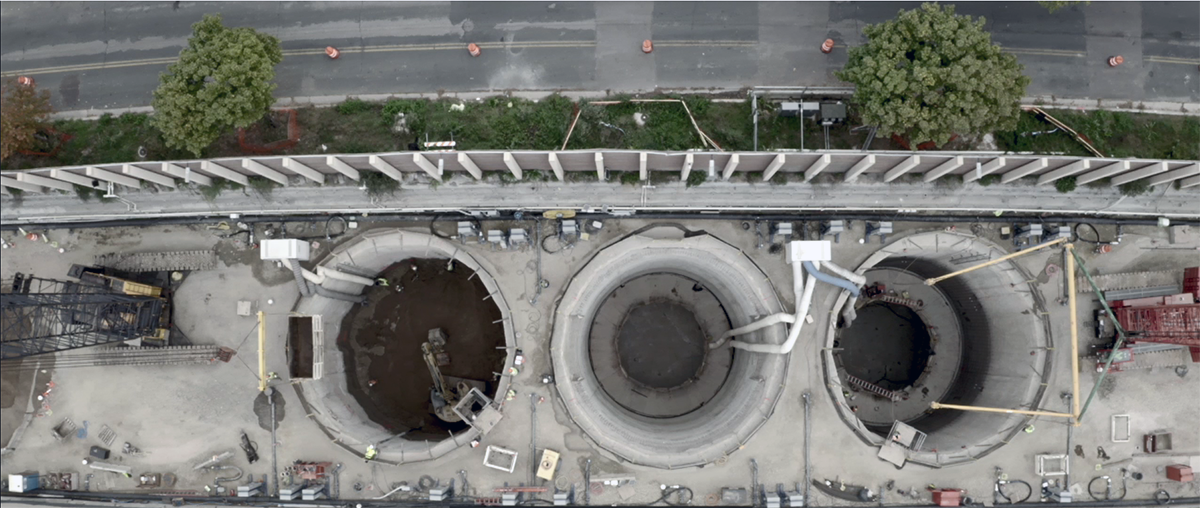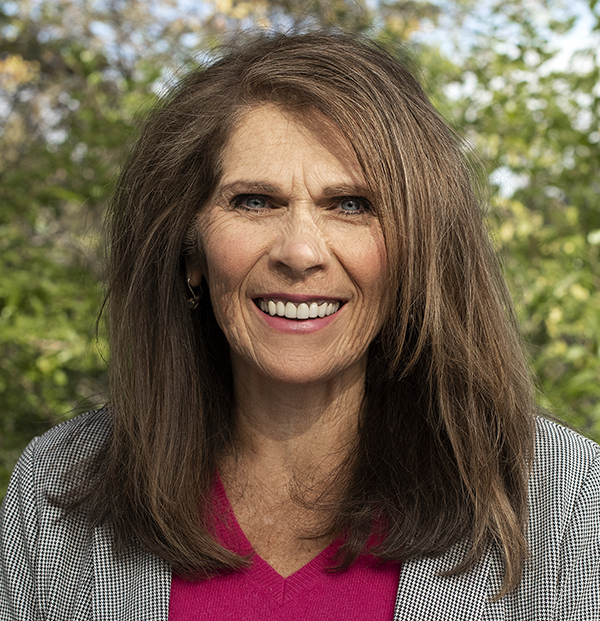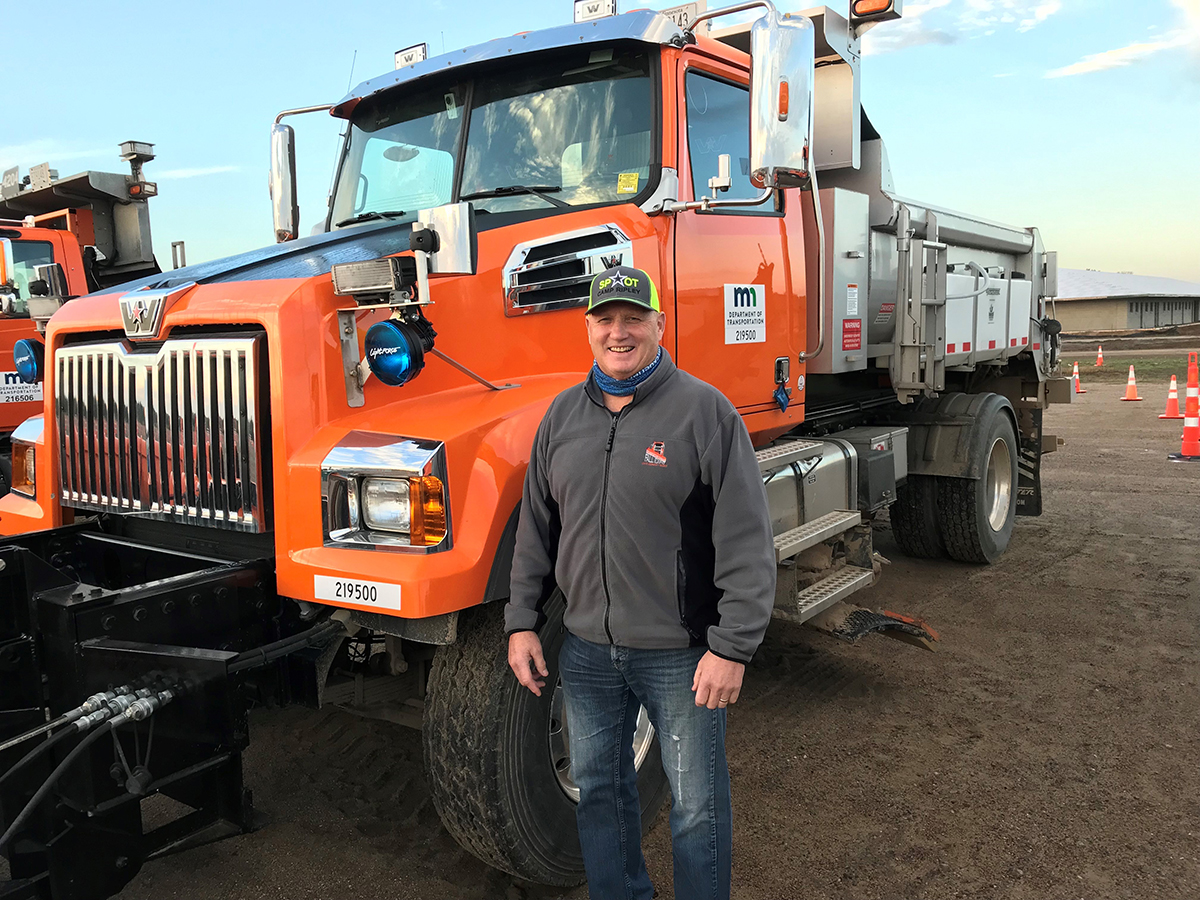 |
|

|
 |
TABLE of CONTENTS
 |
Drone captures bird's-eye view of I-35W water tank project |

Crews are excavating the fourth of six storm water retention tanks on Interstate 35W between 40th and 42nd streets in Minneapolis. These tanks, profiled in the Sept. 1 Newsline, will reduce the flooding risk on the freeway by holding 4.56 million gallons of rain water, or the equivalent of seven Olympic-sized swimming pools. The liner of Cell 3 (center) is complete and crews in cell 2 (right) are working on the liner concrete, which was being poured and finished Oct. 25. Photo by Mastcom |
| |

|
 |
TABLE of CONTENTS
 |
Revamped program aims to pair mentors, mentees |
By Joseph Palmersheim
The Office of Equity and Diversity recently relaunched a revamped Mentor and Sponsor Program at MnDOT.
The two-year program aims to give employees additional support and guidance via mentorship and sponsorship relationships. All employees are eligible to participate.
The new program has roots in a mentorship program created in 2015 to address a stated need from MnDOT employee resource group members for more support within the agency. Development of the sponsorship component began in 2019.
“As part of natural growth and development, there was a desire to formalize the program in ways that more directly measure program outcomes and impact,” said Frida Alvarez, Diversity and Inclusion organizational development specialist. “I had the opportunity to build on the foundation already established by my predecessor, Mary Young. The process for revamping the program included convening an advisory council, reviewing the mentorship archives, and polling past participants.”
Mentoring is led by the mentee, and is based on the mentee’s goals and interests. It is an opportunity to learn about themselves, the direction they want to go as well as build self-esteem and leadership skills.
Sponsorship is led by the sponsor. It is about developing the protégé (the level after “mentee”) to their potential through assignments and other program activities.
All matches start as mentorships. The mentor can request that the mentorship turn into a sponsorship depending on the mentee’s readiness and if the mentee has met the program requirements, like diversity training, involved in or completed the Leadership Development Program.
Mentor/mentee pairs are required to meet for at least 30 minutes at least twice a month, either virtually or in person.
“I hope this program encourages and develops holistic, authentic, inspired and empowered employees,” Alvarez said. “Research has shown that participating in mentorship programs increases employees’ retainability, and their sense of belonging and inclusion at work. Programs like this demonstrate a learning environment where we can grow together.”
Interested in learning more? Two upcoming informational Teams meetings are available: Thursday, Nov. 4, noon to 1 p.m., and Thursday, Nov. 18, 8-9 a.m.
Applications for the program are available online.
| |
|

|
 |
TABLE of CONTENTS
 |
Michael Beer named assistant division director for Engineering Services |
Michael Beer will serve as the new assistant division director in the Engineering Services Division, effective Oct. 27.
Beer most recently served as the assistant district engineer for construction in the Metro District. During his time at Metro District, Beer held leadership positions on major projects like the St. Croix River Crossing and the Hwy 169/Interstate-494 Interchange design-build project. He brings more than 25 years of project delivery experience to this new role.
Beer succeeds Mark Gieseke, who now serves as assistant commissioner for Engineering Services.
|
| |
|

|
 |
TABLE of CONTENTS
 |
New Title VI and Non-Discrimination Policy approved |
Commissioner Margaret Anderson-Kelliher recently approved and signed MnDOT’s new Title VI and Non-Discrimination Policy.
Prior to this, the Office of Civil Rights maintained an office-specific Title VI Policy Statement intended to meet federal Title VI reporting requirements. The new policy updates the prior Title VI Policy Statement and elevates it to a formal agency-wide policy.
MnDOT’s compliance with Title VI of the Civil Rights Act of 1964 is intended to identify and reduce the risk of discriminatory disparities and inequities across the department’s programs and activities. Creating an agency-wide policy lays the groundwork for mitigating the risk of discrimination and reducing disparate impacts.
“The new policy strengthens MnDOT’s Title VI program and signals to MnDOT staff, external partners, and the public that the agency is committed to operating in an equitable and non-discriminatory manner,” said Sean Skibbie, OCR interim director. “The policy also provides more structure and defines the important roles and responsibilities related to our Title VI program.”
The new policy reflects federal and state law, including all the available protected classes. Title VI prohibits MnDOT and its financial subrecipients from discriminating against the public based on race, color or national origin. Other federal non-discrimination legal authorities add protections based on age, disability, sex and low-income status. At the state-level, the Minnesota Human Rights Act prohibits discrimination in the provision of public services based on race, color, creed, religion, national origin, sex, marital status, disability, gender identity, sexual orientation and status with regard to public assistance.
MnDOT’s Title VI Coordinator will provide a review of the new policy to office and district Title VI Liaisons during the annual Title VI training sessions this winter. Contact Byron Millea with questions about the new policy.
|
| |
|

|
 |
TABLE of CONTENTS
 |
Managers’ Workshop exercise encourages participants to dream |
By Joseph Palmersheim

This was one of more than 130 participant responses collected and displayed during an “I dream of wild ___” visioning session at MnDOT’s recent Managers’ Workshop. The responses were collected and then formatted with a natural background before being displayed. Submitted graphic |
Fill in the blank at the end of this sentence: “I dream of wild ___.”
More than 130 employees filled in that blank during a session at MnDOT’s Managers’ Workshop that was held virtually Oct. 11-12. Responses ranged from “Freedom” to “I dream of living in a world where we rely less on our cars and where [there is] frequent transit on every collector roadway. Everyone takes transit - you see your neighbors on the train or on the bus. Everyone mixes.”
Responses were shared live during the 90-minute session. Marcus Young, transportation equity fellow and MnDOT’s artist in residence, was one of the session facilitators (along with Jessica Oh, strategic partnerships director, Sustainability and Public Health Division; and Katie Walker, director, Research & Innovation).
“This was meant to encourage people to have familiarity with their dreams, and the word ‘wild,’ meaning getting closer to your edge of courage and creativity,” Young said. “Everyone knows about dreams. They are very natural. When you are a child, you blow out candles on your birthday cake. So how can we bring that hope, that energy, to work? It’s that feeling of being able to wish very far and build a place from your visions, your dreams, instead of maintaining what is already existing.”
Other responses included:
- “I dream of commutes and road trips that are more restorative than draining, where other road users are perceived as members of our community rather than as obstacles, where we have efficiency without haste, and where we feel a connection to the land.”
- “I dream of a wild MnDOT that is willing to take risks, that is not inhibited by what a legislator may or may not say. I dream of a MnDOT that has the courage to do the right thing, even when it's hard, even when there are competing priorities.”
- “I dream of wildlife passages over and under roads for safe passage of wildlife and non-curbed roads so turtles can get across streets safely because they can’t climb over curbs.”
- “I dream of wild collaborations and connections. Where expertise is respected but no one is ‘territorial’ and barriers only exist in the context of safety. Where equity is always understood, practiced and fully embraced.”
Young said the intent behind sharing these dreams was also meant to inspire an awareness of other peoples’ stories. Doing so, he said, could make the agency be more people-centered.
“While MnDOT is an engineering-based agency, that doesn’t mean it can’t be a cultural force, an expressive force,” Young said. “We can both make everything functional and safe, and make everything expressive and bring experiential delight to our lives. We contribute to people’s sense of belonging and freedom. We need to think of that full dimensionality of our work.”
Among other topics, this year’s Managers’ Workshop featured presentations on “Change, Transition and Resilience” by Landyn Prescott-Miles from the state’s Employee Assistance Program; a transportation update from Robin Hutcheson, USDOT deputy assistant secretary for safety policy; and an update on MnDOT’s new strategic plan, which is expected to launch in early 2022.
|
| |
|

|
 |
TABLE of CONTENTS
 |
Langenbach honored with Minnesota TZD award |
By Joseph Palmersheim

Diane Langenbach. Photo by Rich Kemp |
Diane Langenbach, a Metro District principal engineer for Carver and Scott counties, was recently honored with a Minnesota Toward Zero Deaths Engineering Star Award.
Langenbach was recognized for her efforts to reduce severe crashes at expressway intersections. She served as the project manager on the Hwy 212 reduced-conflict intersection project in Cologne, which featured one of the first RCIs installed in the state.
“Keeping people safe on our highways is very rewarding work,” the 20-year MnDOT employee said. “I wasn’t expecting to be recognized for this, but it’s a very nice surprise.”
MnDOT built the Hwy 212 Cologne RCI in 2012. Six fatal crashes had happened in the area since 2001.
“We didn’t have a project programmed there, but after two fatal crashes in 2011, we knew we needed to do something quickly,” Langenbach said. “Fortunately, the Department of Public Safety had an RCI grant available at that time and this allowed us to deliver the project the following year. Since that RCI was built, we haven’t had a single serious injury or fatal crash. We’ve had similar results at other state-wide RCIs and that’s why we’ve been building more of them.”
An RCI eliminates high-risk left turns and crossing movements on four-lane, high-speed roadways. It breaks these high-risk movements into two safer moves. Instead of crossing and turning left, a driver turns right and then gets into a left turn lane to make a U-turn. The safety data shows that RCIs are very effective in reducing crashes, especially the serious and fatal ones, Langenbach said.
There are also savings with materials and time. The cost of an RCI is a fraction that for an interchange, and they are also less expensive than building a full intersection with a traffic light. The entire RCI maneuver can take less time than it takes to wait for a gap in four lanes of high-speed traffic.
“I’m really proud of the work we all did to make this project happen in such a short time,” Langenbach said. “I had the privilege to get to know the woman who lost her husband in the last fatal crash. She came to the public meeting with a photo of him, and it made such an impact on me and the entire room. It showed the human side of the engineering work we do and why it’s so important to find an effective solution. I’m very thankful that we were able to construct the RCI. Hopefully, the intersection continues to safely operate like it has been for almost 10 years. This success makes me want to work on more RCI’s and we’ve seen many more constructed on Hwy 212 and Hwy 169 as well.”
Langenbach is one of 11 award winners receiving Minnesota Toward Zero Deaths Awards during the 2021 TZD state conference, held virtually Oct. 13 through Nov. 17.
|
| |
|

|
 |
TABLE of CONTENTS
 |
RTMC road weather alerts project is finalist for tech award |
By Micaela Resh, Office of Research & Innovation
The Regional Transportation Management Center’s highway weather alert project is a finalist for the Minnesota Technology Association 2021 Tekne Awards in the Digital Transformation category.
“National Weather Service Blizzard Warnings are now automatically integrated and posted to Digital Message Signs throughout the state, increasing timeliness and accuracy of urgent messages to motorists, enhancing safety and improving customer service,” said Brian Kary, director of traffic operations.
In a collaboration with MNIT and SRF Consulting, MnDOT developed a software interface system that acquires weather alerts from the National Weather Service system, translates them into text messages, selects the appropriate DMS location, and posts the alert message until it expires.
The Road Weather Message System, a new module, was added to MnDOT’s existing Intelligent Roadway Information System to acquire National Weather Service weather alert data (type, location, duration and severity) and generate a message for appropriate digital message signs. Staff can allow the system to automatically display the alert or require an operator to review it first. Messages are monitored and updated automatically as new information is released from the weather service. Operators may modify or cancel the alerts at any time, and messages are removed automatically when an alert expires.
The 2021 Tekne Awards celebration on Nov. 17 will announce winners among the finalists in 13 categories.
For the past two decades, the Tekne Awards have recognized organizations that are leading-edge innovators in science and technology throughout Minnesota.
To learn more, visit MnDOT’s Office of Research & Innovation.
|
| |
|

|
 |
TABLE of CONTENTS
 |
On the Job: Rick Shomion helps train plow drivers |
By Joseph Palmersheim

Rick Shomion, maintenance training coordinator, works at annual Snow Plow Operator Training sessions around the state, like this one in Camp Ripley on Oct. 19. Photo by Eric Prigge |
Rick Shomion, maintenance training coordinator, has been with MnDOT for nearly 35 years. He performs a variety of functions in his role, including working at annual Snow Plow Operator Training sessions around the state.
What do you find interesting about your job?
There is a lot of variety in the things I end up working on. I really enjoy working with the military and being on site at Camp Ripley to deliver snowplow operator training. Through a coordinated effort of numerous talented people, we have been able to successfully train more than 2,600 MnDOT and local agency drivers at SPOT over the past 18 years.
How has SPOT changed since you started?
While the technology and the make-up of the trucks has changed over the years, the end goal has is the same. We are trying to make the operators comfortable in operating the trucks and all the components, so that when they are out there during a snow and ice event among the traffic and snow clouds, etc., they feel confident in being able to get the job done.
How have technological advances impacted or improved the way we plow?
In our ongoing effort to minimize the amount of salt and other chemicals we are using on the roadway and maximizing the effectiveness of it, the introduction of Maintenance Decision Support System has helped us immensely. By utilizing MDSS, we have taken some of the guess work out of how much chemical to use during a given snow and ice event.
What’s your favorite part about what you do?
I get to work with all levels of MnDOT. I make presentations to various management groups, as well as seek advice and approval from them. I also get to work closely with the front-line maintenance workers who are the bread and butter of MnDOT. At times I get to be an ambassador for the department in dealing with different news media to deliver a message about the readiness of our maintenance workforce for the upcoming snow and ice season.
Anything else you’d like to add?
I have had the good fortune of working with many well-educated, well-meaning and talented individuals over the course of my career. And I have been afforded many wonderful opportunities over the past 35 years.
Do you or a co-worker have an interesting job to share with readers? Send us your ideas, and we’ll contact you for more information.
Recent employee profiles:
|
| |
|
| |
|



